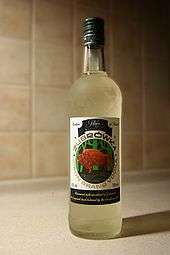Żubrówka
 | |
| Type | flavored vodka |
|---|---|
| Manufacturer | Polmos Białystok (Poland), Belalco (Belarus), Bulbash (Belarus),[1] Minsk Kristall (Belarus)[2] and others |
| Country of origin | Poland |
| Introduced | 16th century |
| Proof (US) | 80 |
| Related products | List of vodkas |
Żubrówka (Polish pronunciation: [ʐuˈbrufka] (![]()
The rye distillate is flavoured with a tincture of bison grass (Hierochloe odorata), which also gives the spirit its yellowish color. This grass grows in the Białowieża Forest and elsewhere. A blade of bison grass is traditionally placed in each bottle of żubrówka, though this is largely decorative.
Since the beginning of the 21st century, there are also new brands available in Poland, such as Żubrówka Biała Wódka (white), Żubrówka Czarna Wódka (black) and Żubrówka Złota (gold).
Etymology
The words zubroŭka in the Belarusian language and zubrovka in Russian are the words for bison grass. In Polish, the word turówka is used for the grass. The name comes from zubr (Polish: żubr, pronounced [ʐubr]), the word for the European bison in many Slavic languages.
History
The zubrovka has been produced since at least the 16th century[1] in the Polish-Lithuanian Commonwealth, in the region of the contemporary Polish-Belarusian border. By the 18th century it was one of the favorite raw drinks of nobility (szlachta) and peasantry alike.
In the 19th century, the famous Odessa-based brandy manufacturer Shustov began producing żubrówka.[3]
In 1926, the company Polmos from Brześć nad Bugiem (now Brest, Belarus) invented a method to mass-produce żubrówka, which was then copied by numerous companies worldwide, under a variety of brand names. The original distillery company in Brest (nationalized by the Soviets after 1939 and now known under the name Belalco) still produces Brestskaya Zubrovka. There are also brands of zubrovka in many countries including Lithuania (Stumbrinė), United States (Bison Vodka), Ukraine (Зубрiвка, Zubrivka), Germany (Grasovka and Blauer Bison), Russia (Зубровка, Zubrovka), the Czech Republic (Zubrovka), and others.
The brand
Currently the brands Zubrovka and Żubrówka are registered by Sojuzplodoimport/Russia and the Polmos Białystok company in Białystok, Poland.[4] However, żubrówka is considered a generic name for a type of liquor by the U.S. Patent and Trademark Office, so anyone may use the name for products in the United States, and the name has been used by various companies there.[4]
In popular culture
- Żubrówka is mentioned in Moscow-Petushki, a pseudo-autobiographical postmodernist prose poem by Russian writer and satirist Venedikt Yerofeyev.
- The bison emblem (Mylvivä härkä, "roaring bull") of Fighter Squadron 11, Lapland Air Command, Finnish Air Force, originated from the label of Polmos Żubrówka. It was introduced in 1941 as the emblem of PLeLv 46, on its Dornier 17 bombers, and later adopted by Fighter Squadron 11. Pilots of PLeLv 46 had seen the Żubrówka label while picking up Do 17 bombers from Warsaw.[5]
- Żubrówka figures prominently in the movie Suzhou River.
- Żubrówka is featured in W. Somerset Maugham's novel The Razor's Edge (and in the 1984 film adaptation).
- The name of the country Żubrówka in the movie The Grand Budapest Hotel is named after this style of vodka.
- Navy SEAL Chris Kyle mentions it in his book American Sniper while working with the Polish GROM.
In the United States

The tincture of bison grass found in żubrówka is prohibited as a food additive by the Food and Drug Administration because it contains coumarin, which showed hepatotoxic effects in rats and has a blood thinning effect.[6] Importation of żubrówka was banned in 1978 by the Bureau of Alcohol, Tobacco and Firearms. Canada has no similar regulations on coumarin, so the alcoholic drink is legal there.
When produced according to traditional methods (between one and two kilograms of grass per thousand litres of alcohol), żubrówka contains approximately 12 milligrams of coumarin per litre. In 1999, distilleries that were not connected with the Polish brand introduced lower quality reformulated versions of the product,[4] sometimes using artificial flavours and colors, with the emblematic blade of grass in every bottle but "neutralised" so as to be coumarin-free. In 2011 the American licensee of the Polish company worked with Rémy Cointreau to introduce a new American formulation, which they called "Żu".[4]
In addition to the coumarin problem, American authorities determined that the trademark on Żubrówka brand was diluted and unenforceable, as it was a generic name, like aspirin.[4]
Serving suggestions
Like most vodkas, żubrówka is usually served chilled on its own. A very popular alternative is mixing it with apple juice[7] (a drink known in Polish as tatanka (Lakota for "American bison") or szarlotka (Polish for "apple cake"); known in the UK as a Frisky Bison;[8] and in the US as a Polish Kiss). It is sometimes served over vanilla ice cream,[9] and another common mixer is ginger ale.[9] While a "Black Bison" is żubrówka mixed with black currant juice.
References
- 1 2 Бульбашъ Зубровая [Bulbash Zubrovaya, a brand of Zubroŭka from Belarus]
- ↑ Белорусская зубровка
- ↑ Валентин Крапива. Это сладкое слово "Шустов" [Valentin Krapiva. This sweet word Shustov - ]
- 1 2 3 4 5 Michaels, Daniel (2011-01-18). "Name Your Poison: How a Banned Polish Vodka Buffaloed Its Way Into the U.S." Wall Street Journal.
- ↑ "kaiken takana on tarina". virtuaalibaari.fi (in Finnish). Retrieved 2017-11-25.
- ↑ Fabricant, Florence (2010-11-30). "Polish Vodka Arrives with a Wisp of Grass". New York Times. Retrieved 2013-06-11.
- ↑ Gim, Sarah (2006-07-18). "Zubrowka is bison grass vodka". Retrieved 2007-09-29.
- ↑ Cocktail:UK - Frisky Bison Cocktail
- 1 2 "Zubrowka Ginger Ale and ice cream". 2018-05-25. Retrieved 2018-05-25.
External links
| Wikimedia Commons has media related to Żubrówka. |
- Polmos Białystok official site
- Zubrowka.com—The official site for the Bison Grass Vodka
- Belalco—the official site of the Brest Distillery Company
- Zubrowka: Polish Vodka and Cultural Geographic Indicators